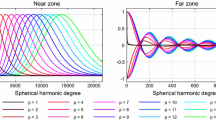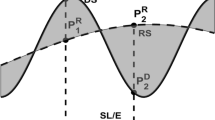Abstract
The determination of the gravimetric geoid is based on the magnitude of gravity observed at the surface of the Earth or at airborne altitude. To apply the Stokes’s or Hotine’s formulae at the geoid, the potential outside the geoid must be harmonic and the observed gravity must be reduced to the geoid. For this reason, the topographic (and atmospheric) masses outside the geoid must be “condensed” or “shifted” inside the geoid so that the disturbing gravity potential T fulfills Laplace’s equation everywhere outside the geoid. The gravitational effects of the topographic-compensation masses can also be used to subtract these high-frequent gravity signals from the airborne observations and to simplify the downward continuation procedures. The effects of the topographic-compensation masses can be calculated by numerical integration based on a digital terrain model or by representing the topographic masses by a spherical harmonic expansion. To reduce the computation time in the former case, the integration over the Earth can be divided into two parts: a spherical cap around the computation point, called the near zone, and the rest of the world, called the far zone. The latter one can be also represented by a global spherical harmonic expansion. This can be performed by a Molodenskii-type spectral approach. This article extends the original approach derived in Novák et al. (J Geod 75(9–10):491–504, 2001), which is restricted to determine the far-zone effects for Helmert’s second method of condensation for ground gravimetry. Here formulae for the far-zone effects of the global topography on gravity and geoidal heights for Helmert’s first method of condensation as well as for the Airy-Heiskanen model are presented and some improvements given. Furthermore, this approach is generalized for determining the far-zone effects at aeroplane altitudes. Numerical results for a part of the Canadian Rocky Mountains are presented to illustrate the size and distributions of these effects.
Similar content being viewed by others
References
Bruns H (1878) Die Figur der Erde. Publ. Preuss. Geod. Inst., Berlin
Claessens S (2003) A synthetic Earth model; analysis, implementation; validation and application. Delft University Press, Delft
Forsberg R (1984) A study of terrain reductions, density anomalies and geophysical inversion methods in gravity field modelling. Rep 355, Department of Geodetic Science, The Ohio State University, Columbus
Forsberg R (1985) Gravity field terrain effect computations by FFT. Bull Géod 59: 342–360
Gradshteyn IS, Ryzhik IM (1980) Tables of integrals, series, and products. Academic Press, New York
Grüninger W (1990) Zur topographisch-isostatischen Reduktion der Schwere. PhD Thesis, Universität Karlsruhe
Heck B (2003) On Helmert’s methods of condensation. J Geod 77(3–4):155–170. doi:10.1007/s00190-003-0318-5
Heiskanen WA, Moritz H (1967) Physical geodesy. Freeman, San Francisco
Helmert FR (1884) Die mathematischen und physikalischen Theorien der höheren Geodäsie. vol 2. B. G. Teubner, Leipzig
Kuhn M, Seitz K (2005) Comparison of Newton’s integral in the space and frequency domains. In: Sansó F(eds) A Window on the future of geodesy, IAG Symposia 128. Springer, Heidelberg, pp 386–391
Lambeck K (1988) Geophysical geodesy: the slow deformations of the Earth. Clarendon Press, Oxford
Makhloof AA, Ilk KH (2006) Effects of topographic-compensation masses on gravitational functionals at the surface of the Earth, at airborne and satellite altitudes. J Geod 82(2):93–111. doi:10.1007/s00190-007-0159-8
Martinec Z (1998) Boundary value problems for gravimetric determination of a precise geoid. Lecture notes in earth sciences, vol 73. Springer, Berlin
Martinec Z, Vaníček P (1994a) Direct topographical effect of Helmert’s condensation for a spherical approximation of the geoid. Manuscr Geod 19: 257–268
Martinec Z, Vaníček P (1994b) Indirect effect of topography in the Stokes-Helmert technique for a spherical approximation of the geoid. Manuscr Geod 19: 213–219
Martinec Z, Matyska C, Grafarend EW, Vaníček P (1993) On Helmert’s second condensation method. Manuscr Geod 18: 417–421
Molodenskii MS, Eremeev VF, Yurkina MI (1960) Methods for the study of the external gravitational field and figure of the Earth. [translated from Russian by the Israel Program for the Scientific Translations, Office of Technical Services, Department of Commerce, Washington, DC, 1962]
Nagy D (1966) The gravitational attraction of a right rectangular prism. Geophysics 31: 362–371
Nagy D, Papp G, Benedek J (2000) The gravitational potential and its derivatives for the prism. J Geod 74(7–8):552–560. doi:10.1007/s001900000116
Nagy D, Papp G, Benedek J (2002) Corrections to “The gravitational potential and its derivatives for the prism”. J Geod 76(8):475. doi:10.1007/s00190-002-0264-7
Novák P (2000) Evaluation of gravity data for Stokes-Helmert solution to the Geodetic Boundary-value Problem. Ph. D Thesis, Department of Geodesy and Geomatics Engineering, University of New Brunswick
Novák P, Grafarend EW (2005) The ellipsoidal representation of the topographical potential and its vertical gradient. J Geod 78(11–12):691–706. doi:10.1007/s00190-005-0435-4
Novák P, Vaníček P, Martinec Z, Véronneau M (2001) Effect of the spherical terrain on gravity and the geoid. J Geod 75(9–10):491–504, doi:10.1007/s001900100201
Rummel R, Rapp RH, Sünkel H, Tscherning CC (1988) Comparisons of global topographic-isostatic models to the Earth’s observed gravity field. Rep 388, Department of Geodetic Science, The Ohio State University, Columbus
Sideris MG (1985) A fast Fourier transform method for computing terrain corrections. Manuscr Geod 10: 66–73
Sjöberg LE, Nahavandchi H (2000) The atmospheric geoid effects in Stokes’s formula. Geophys J Int 140: 95–100
Smith DA, Robertson DS, Milbert DG (2001) Gravitational attraction of local crustal masses in spherical coordinates. J Geod 74(11–12):783–795. doi:10.1007/s001900000142
Sneeuw N, Bun R (1996) Global spherical harmonic computation by two-dimensional Fourier methods. J Geod 70(4):224–232. doi:10.1007/s001900050011
Schwarz K-P, Sideris MG, Forsberg R (1990) The use of FFT techniques in physical geodesy. Geophys J Int 100:485–514
Tsoulis D (1999) Analytical and numerical methods in gravity field modelling of ideal and real masses. Reihe C, Heft Nr 510, Deutsche Geodätische Kommission, München
Vaníček P, Huang J, Novák P, Pagiatakis S, Véronneau M, Martinec Z, Featherstone W (1999) Determination of boundary values for the Stokes-Helmert problem. J Geod 73(4):180–192. doi:10.1007/s001900050235
Vaníček P, Novák P, Martinec Z (2001) Geoid, topography, and the Bouguer plate or shell. J Geod 75(4): 210–215
Wichienchareon C (1982) The indirect effects on the computation of the geoid undulations. Rep 336, Department of Geodetic Science, The Ohio State University, Columbus
Author information
Authors and Affiliations
Corresponding author
Rights and permissions
About this article
Cite this article
Makhloof, A.A., Ilk, K.H. Far-zone effects for different topographic-compensation models based on a spherical harmonic expansion of the topography. J Geod 82, 613–635 (2008). https://doi.org/10.1007/s00190-008-0214-0
Received:
Accepted:
Published:
Issue Date:
DOI: https://doi.org/10.1007/s00190-008-0214-0




